
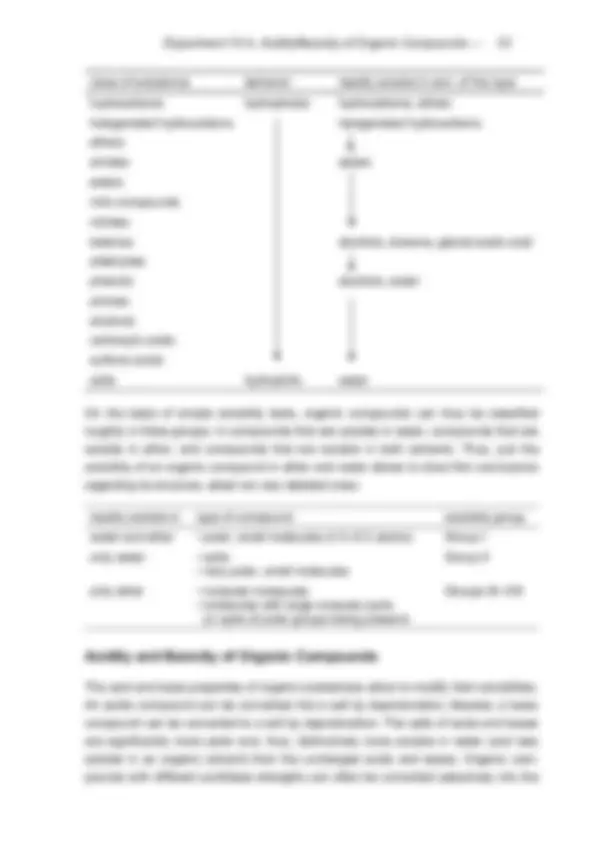

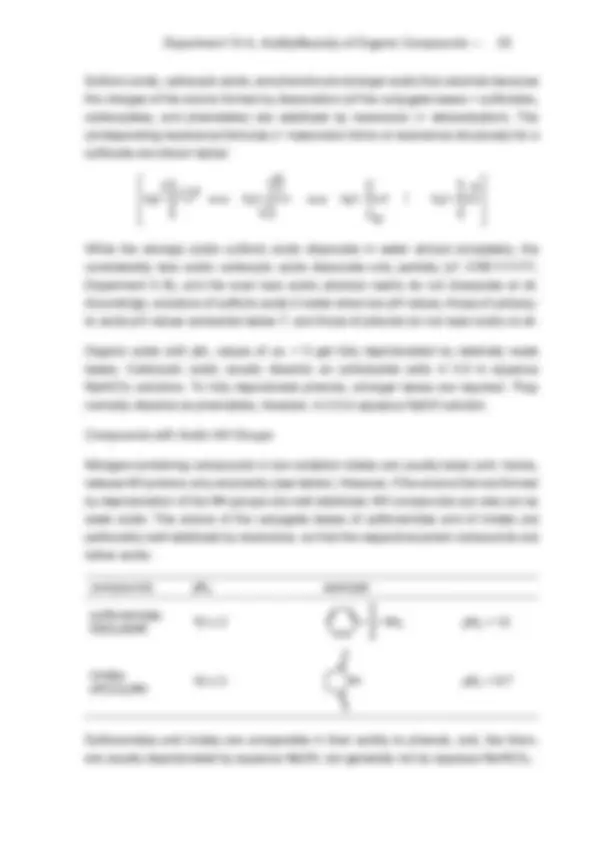
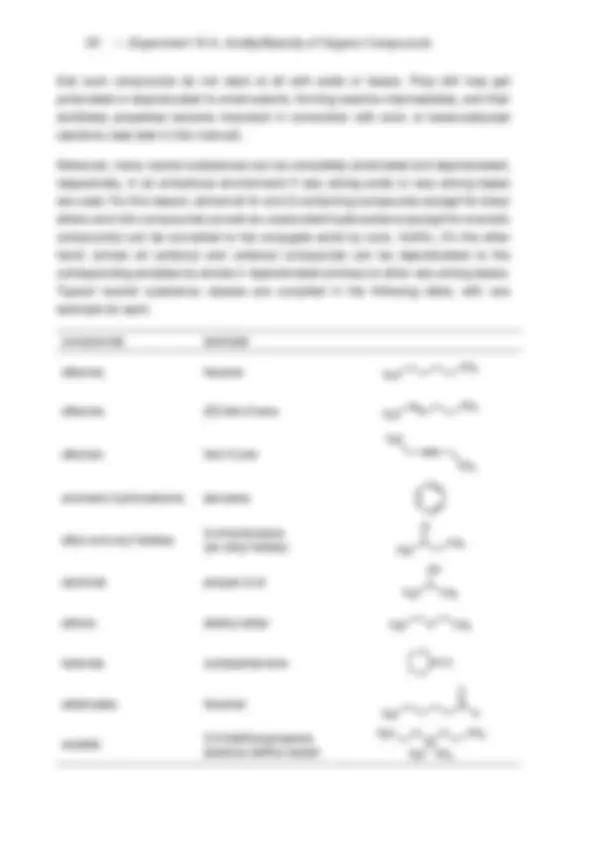
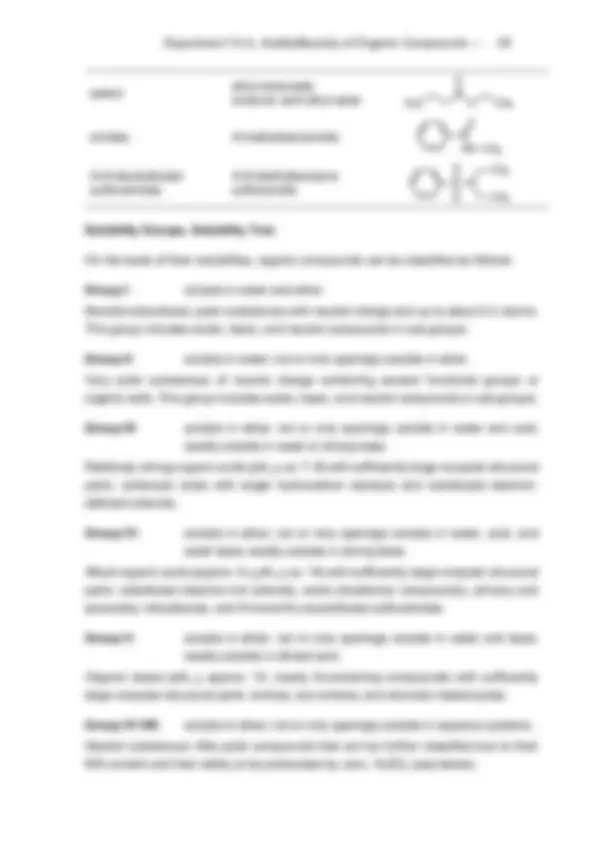

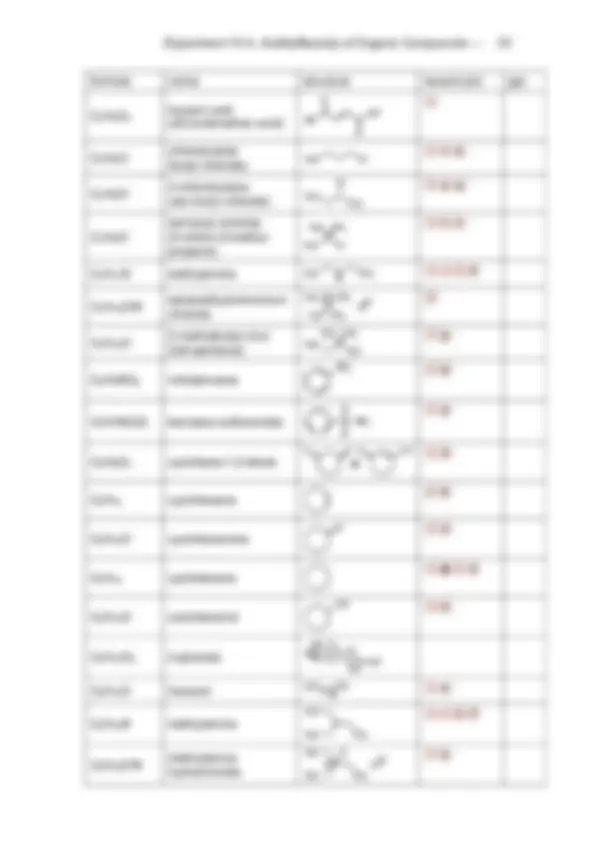
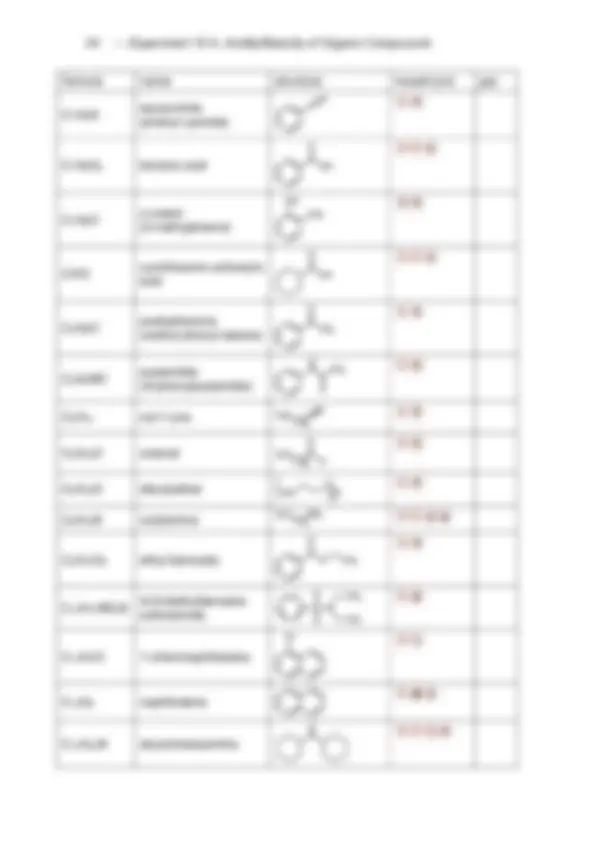
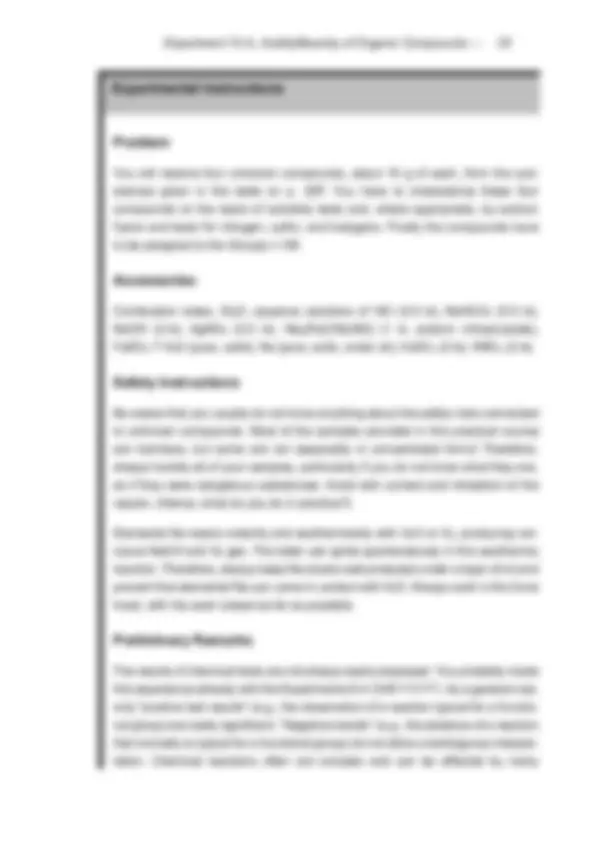
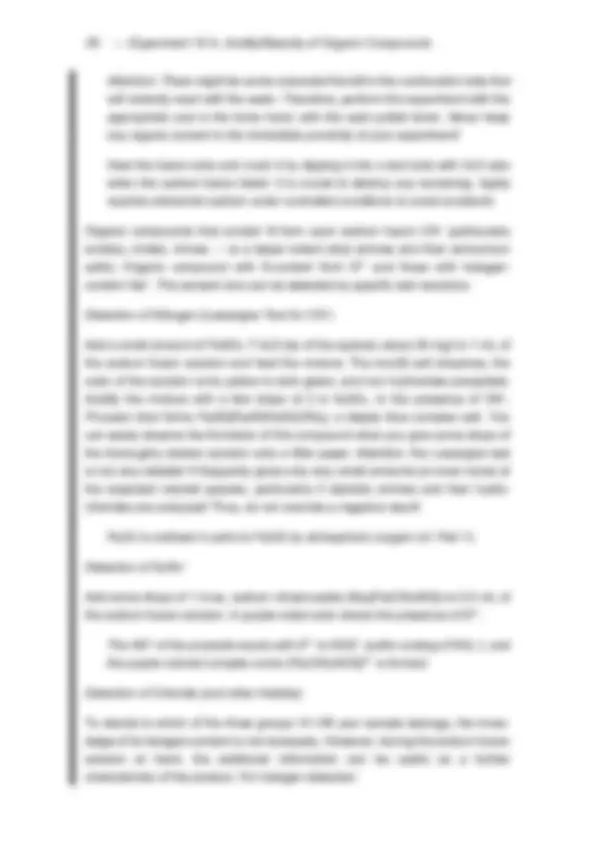
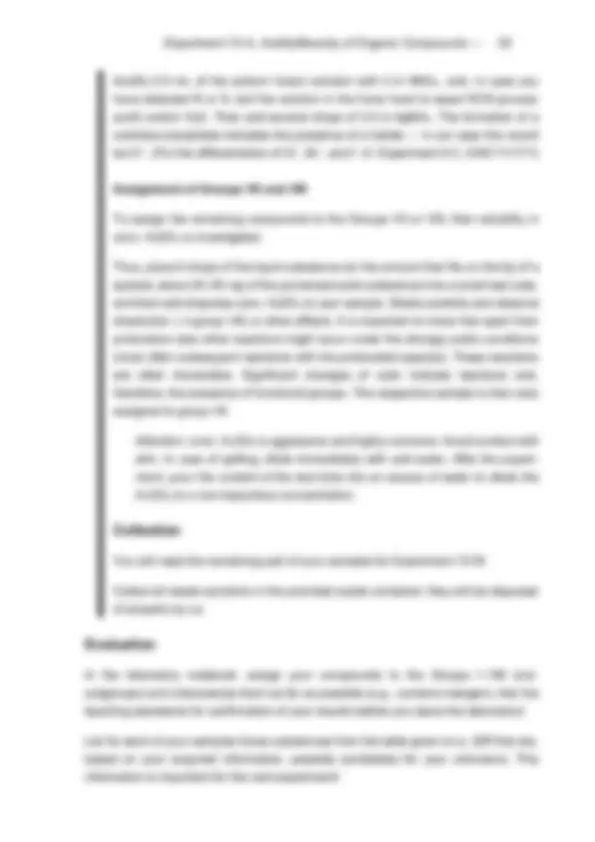


Study with the several resources on Docsity

Earn points by helping other students or get them with a premium plan


Prepare for your exams
Study with the several resources on Docsity

Earn points to download
Earn points by helping other students or get them with a premium plan
Community
Ask the community for help and clear up your study doubts
Discover the best universities in your country according to Docsity users
Free resources
Download our free guides on studying techniques, anxiety management strategies, and thesis advice from Docsity tutors
Functional groups of organic compounds
Typology: Lecture notes
1 / 19

This page cannot be seen from the preview
Don't miss anything!












10. Functional Groups of Organic Compounds — 21
Organic Chemistry deals with compounds that are primarily based on the element carbon. Carbon atoms can be bonded through single, double, or triple bonds to other carbon atoms, forming chains, rings, polycycles, or other frameworks of virtually any sizes. They form stable bonds also to other elements, most often hydrogen, oxygen, and nitrogen but also sulfur, the halogens, and, less frequently, any of the other ele- ments of the periodic table. The diversity of structural possibilities of carbon compounds results in the fact that by now already more than 25 million organic compounds are known, which all differ in their physical and chemical properties. A certain classification of the compounds is therefore required. Organic compounds can be classified according to a variety of criteria. For instance, naturally occurring compounds (natural products) can be distinguished from synthetic substances, toxic from non-toxic, and volatile from less volatile compounds, etc. From a chemical point of view it makes sense to classify substances on the basis of their chemical reactivities, which are closely connected to the functional groups contained in a molecule. For this reason we focus at the beginning of this course on the common functional groups of organic molecules. The following experiments deal with the differentiation and identification of the most important functional groups of organic compounds. We will not go into the details of their chemical behaviors here; this will be done in the lecture courses. At this point we will focus in a first step on the acid–base properties of functionalized organic com- pounds, following up the concepts already taught before. In the subsequent experi- ments, specific reactivities of functional groups are used for their identification. The related chemical theory exceeds the scope of this course, and we do not ask you to understand it fully. For the sake of completeness, we nevertheless provide chemical explanations for the reactions performed with the several tests. The individual experiments in Chapter 10 are: Experiment 10 A Acidity/Basicity of Organic Compounds Experiment 10 B Tests for Functional Groups Experiment 10 C Analysis of an Unknown Mixture
22 — Experiment 10 A, Acidity/Basicity of Organic Compounds
Important information about organic compounds and their functional groups can already be obtained by simple solubility tests. In Experiment 10 A, you will acquire a technique that allows you to quickly characterize unknown compounds and to classify them on the basis of their polarity and acid–base properties. You will become acquain- ted with a “solubility theory”, which you need as the basis to understand and apply the most common working-up procedure in Organic Chemistry — the extraction. You already separated two organic compounds by the extraction procedure (Experiment 5 A, CHE111/171), and here you learn more about the chemistry behind it. Additionally, you will recollect the most important functional groups that you already (might) have encountered in lecture courses or at high school.
We have already dealt extensively with the solubility of chemical substances in CHE111/171. In Chapter 4 you were given a set of solubility rules for inorganic salts that allow the quick prediction of the solubility properties of a given inorganic com- pound. No comparable rules are available for organic compounds. In Organic Che- mistry we primarily rely on the rule “ like dissolves like” , which was already introduced in Experiment 4 B (see also table on the next page). The following table shows that the hydrophobic/hydrophilic properties of an organic compound can be correlated rather directly to its functional groups. However, the total structure of a molecule is not considered in the table, and the indicated behaviors merely relate to the “local polarities” in the vicinity of the functional groups. This means, e.g. , that a carboxylic acid always contains a strongly polar and hydrophilic group that allows good interaction with water. However, the acid might also have a significant nonpolar (hydrophobic, lipophilic) hydrocarbon part so that the characteristics of the latter can dominate and dictate the overall properties of the substance. This is the case, e.g. , for fatty acids (cf. Experiment 11 E) that are sparingly soluble in water but very readily soluble in a variety of organic solvents, even in the very nonpolar hydrocarbons. As a rule, most organic compounds are readily soluble in diethyl ether (Et 2 O, frequently called just ether) and only sparingly in water. Exceptions from this rule are functiona- lized compounds with only a few carbon atoms (1 to about 5 C atoms, depending on the functional group), polyfunctionalized compounds, and organic salts. Some of them are poorly soluble in organic solvents but, as a rule, readily soluble in water instead.
24 — Experiment 10 A, Acidity/Basicity of Organic Compounds corresponding salts by controlled deprotonation/protonation using differently strong bases or acids. This can be used to distinguish and separate them. On the basis of different solubilities of organic compounds in neutral, basic, and acidic environments, we can easily distinguish between organic acids, bases, and neutral substances. Below, the functional groups that lead to acidic or basic properties of a compound are shortly introduced. Organic Acids In principle, all compounds that bear at least one hydrogen atom are acids because they all can be deprotonated with a sufficiently strong base. In the proper sense, however, we only call a compound HA an acid when it relatively easily dissociates in aqueous environment to H+^ (H 3 O+) and the conjugate base (A−) (see CHE111/171, Chapter 6); when its pKa is smaller than that of water (pKa(H 2 O) = 15.7). A compound is the more acidic the better the anion formed by deprotonation is stabilized. The acidity of an XH compound accordingly increases within a period of the periodic table from the left to the right, with increasing electronegativity of X. More important than the stabilization of a anion by an electronegative element X, however, is its additional stabi- lization through resonance. Typical organic acids form resonance-stabilized anions as conjugated bases. Compounds with Acidic OH Groups The O–H bond of an OH functionality is polarized, and deprotonation should be readily possible. However, the most typical compounds with OH groups, the alcohols, do not belong to the organic acids despite the strongly electronegative character of the O atom. Their pKa values usually lie about 1–3 units above that of water, and alcohols are accordingly just marginally dissociated in water. Typical organic acids with OH groups are sulfonic and carboxylic acids; phenols and 1,3-diketones (in the enol form, see below) are acidic as well, but to a considerably lesser degree. compounds pKa example sulfonic acids RSO 3 H < 0 pKa = −2. carboxylic acids RCO 2 H < 5 pKa = 4. phenols ArOH 10 ± 3 (approx.) pKa = 10. H 3 C S OH O O H 3 C O OH OH
Experiment 10 A, Acidity/Basicity of Organic Compounds — 25 Sulfonic acids, carboxylic acids, and phenols are stronger acids than alcohols because the charges of the anions formed by dissociation (of the conjugate bases = sulfonates, carboxylates, and phenolates) are stabilized by resonance (= delocalization). The corresponding resonance formulas (= mesomeric forms or resonance structures) for a sulfonate are shown below: While the strongly acidic sulfonic acids dissociate in water almost completely, the considerably less acidic carboxylic acids dissociate only partially (cf. CHE111/171, Experiment 6 B), and the even less acidic phenols nearly do not dissociate at all. Accordingly, solutions of sulfonic acids in water show low pH values, those of carboxy- lic acids pH values somewhat below 7, and those of phenols do not react acidic at all. Organic acids with pKa values of ca. < 5 get fully deprotonated by relatively weak bases. Carboxylic acids usually dissolve as carboxylate salts in 0.5 M aqueous NaHCO 3 solutions. To fully deprotonate phenols, stronger bases are required. They normally dissolve as phenolates, however, in 0.5 M aqueous NaOH solution. Compounds with Acidic NH Groups Nitrogen-containing compounds in low oxidation states are usually basic and, hence, release NH protons only reluctantly (see below). However, if the anions that are formed by deprotonation of the NH groups are well stabilized, NH compounds can also act as weak acids. The anions of the conjugate bases of sulfonamides and of imides are particularly well stabilized by resonance, so that the respective parent compounds are rather acidic. compounds pKa example sulfonamides RSO 2 NHR’ 10 ± 3 pKa = 10 imides (RCO) 2 NH 10 ± 3 pKa = 9. Sulfonamides and imides are comparable in their acidity to phenols, and, like them, are usually deprotonated by aqueous NaOH, but generally not by aqueous NaHCO 3. H 3 C S O O O H 3 C S O O O H 3 C S O O O ∫ H 3 C S O O O S NH 2 O O NH O O
Experiment 10 A, Acidity/Basicity of Organic Compounds — 27 Organic Bases All organic compounds that have functional groups with positions of high electron density, e.g. , electron lone pairs, are potential bases. However, here we again consider as bases only those charge-neutral compounds that can be converted into salts by protonation in an aqueous environment. Thus, the compounds must be comparable or even stronger bases than water. The strength of a base depends on two factors: on the availability of the electron lone pair and on the stabilization of the cation produced by protonation. The availability of the electron lone pair is closely related to its orbital energy. The higher the orbital energy is, the more reactive and, consequently, the more basic the electron pair is. Because the orbital energies decrease with increasing electronegativity of the ele- ments, it is obvious that amines (ENN = 3.1) must be more basic than alcohols (ENO = 3.5). The basicity of N - containing organic compounds varies over a wide range, though, because the availability of the electron lone pair can be limited due to conju- gation. Possible basic compounds that get fully protonated by 0.5 M aqueous HCl and, therefore, can often (but not always) be dissolved in water in form of their ammonium salts are alkyl amines (primary, secondary, and tertiary, cf. the table), aryl amines, and heterocyclic nitrogen compounds. Other N - (and O - ) containing functional groups can also be protonated, if the acids used are sufficiently strong and sufficiently concent- rated, e.g. , conc. H 2 SO 4 (see below). compounds pKb example alkyl amines RNH 2 (prim.) R 2 NH (sec.) R 3 N (tert.) 3.5 ± 1 pKb = 3. aryl amines ArNH 2 9 ± 3 aniline pKb = 9. pyridine type 8 ± 3 pyridine pKb = 8. pyrrole type 15 ± 3 pyrrole pKb = 15. Neutral Substances All organic compounds that are not converted, for the major part, to deprotonated or protonated forms in diluted aqueous HCl or NaOH solutions, respectively, are regarded as neutral substances. The classification “neutral substance”, however, does not mean H 3 C NH 2 NH 2 N N H
28 — Experiment 10 A, Acidity/Basicity of Organic Compounds that such compounds do not react at all with acids or bases. They still may get protonated or deprotonated to small extents, forming reactive intermediates, and their acid/base properties become important in connection with acid- or base-catalyzed reactions (see later in this manual). Moreover, many neutral substances can be completely protonated and deprotonated, respectively, in an anhydrous environment if very strong acids or very strong bases are used. For this reason, almost all N - and O - containing compounds (except for diaryl ethers and nitro compounds) as well as unsaturated hydrocarbons (except for aromatic compounds) can be converted to the conjugate acids by conc. H 2 SO 4. On the other hand, almost all carbonyl and carboxyl compounds can be deprotonated to the corresponding enolates by amide (= deprotonated amines) or other very strong bases. Typical neutral substance classes are compiled in the following table, with one example for each. compounds example alkanes hexane alkenes ( E )-hex- 2 - ene alkynes hex- 3 - yne aromatic hydrocarbons benzene alkyl and aryl halides 2 - chlorobutane (an alkyl halide) alcohols propan- 2 - ol ethers diethyl ether ketones cyclopentanone aldehydes hexanal acetals 2,2-diethoxypropane acetone diethyl acetal H 3 C CH 3 H 3 C CH 3 CH 3 H 3 C H 3 C CH 3 Cl H 3 C CH 3 OH H 3 C O CH 3 O H 3 C O H H 3 C O O CH 3 H 3 C CH 3
30 — Experiment 10 A, Acidity/Basicity of Organic Compounds Group I carboxylic acids, small 1,3-diones sulfonic acids some phenols alcohols aldehydes, ketones esters, amides, nitriles amines Group II polycarboxylic acids small 1,3-dicarbonyl comp. salts of amines (prot. amines) tetrasubst. ammonium salts sugars, polyols amino acids carboxylates (deprot. carboxylic acids) Group III carboxylic acids some phenols Group IV phenols enols (larger 1,3-dicarbonyl comp.) nitro alkanes ( -H-atom) sulfonamides Group V amines aromatic N-heterocycles Group VI aromatic nitro compounds amides, nitriles N, N-disubstituted sulfonamides Group VII alkenes, alkynes alcohols, ethers aldehydes, ketones esters Group VIII saturated hydrocarbons aromatic hydrocarbons alkyl and aryl halides diaryl ethers (A) (A) (A/wA) (N) (N) (N) (A) (wA) (wA) (N) (N) (A, B, N) (A) (A/wA) (wA) (wA) (wA) (wA) (B) (wB) (N) (N) (N) (N) (N) (N) (N) (N) (N) (N) (N) (B) (B) pH < 7 pH > 7 pH≈ 7 pH < 7 pH > 7 pH ≈ 7 NaHCO 3 HCl NaOH H 2 O yes no no yes Et 2 O yes yes no no yes no pH < 7 pH ≈ 7 pH >/≈ 7 pH ≈ 7 pH-measurement with aqueous phase A = acid, wA = weak acid B = base, wB = weak base N = neutral substance polar, small molecules (up to about 5– 6 C atoms) salts and very polar, small molecules nonpolar molecules and molecules with larger nonpolar parts ( dispite polar groups being present) pH of the original solution
Experiment 10 A, Acidity/Basicity of Organic Compounds — 31 Classification of the Neutral Substances The neutral substances can be sub-classified into the Groups VI–VIII. For this, the samples are analyzed qualitatively for their content of N and S (Group VI), and the N/S-free compounds are further classified into the groups VII (can be protonated by conc. H 2 SO 4 ) and VIII (inert toward conc. H 2 SO 4 ): Group VI: not or only sparingly soluble in water, diluted acid, or base; often soluble in ether; contains N and/or S. Neutral substances with N - and/or S - containing functional groups and sufficiently large nonpolar residues. Group VII: not or only sparingly soluble in water, diluted acid, or base; often soluble in ether; contains neither N nor S; soluble in conc. H 2 SO 4. Neutral substances containing O, double, and/or triple bonds that can be protonated by conc. H 2 SO 4 (mostly with decomposition!). Group VIII: not or only sparingly soluble in water, diluted acid, or base; often soluble in ether; contains neither N nor S; insoluble in conc. H 2 SO 4. Neutral compounds that are inert even towards strong acid. The “solubility tree” is supplemented, thus, as follows: To analyze the sample for nitrogen and sulfur (and halogens), the compound is fused with sodium. N - containing compounds produce CN−^ in the sodium fusion, S - containing compounds produce S2−^ (and SCN−, if also N is contained), and halogen-containing substances produce the corresponding halides. The anions can then be identified specifically as learned in CHE111/171, Experiment 9 C. conc. H 2 SO 4 contains N or S? (Groups VI–VIII) yes no yes no Group VII alkenes, alkynes alcohols, ethers aldehydes, ketones esters (N) (N) (N) (N) Group VIII saturated hydrocarbons aromatic hydrocarbons alkyl and aryl halides diaryl ethers (N) (N) (N) (N) Group VI aromatic nitro compounds amides, nitriles N, N-disubstituted sulfonamides (N) (N) (N)
Experiment 10 A, Acidity/Basicity of Organic Compounds — 33 formula name structure hazard pict grp C 4 H 4 O 4 fumaric acid (( E )-butenedioic acid) C 4 H 9 Cl chlorobutane (butyl chloride) C 4 H 9 Cl 2 - chlorobutane ( sec - butyl chloride) C 4 H 9 Cl tert - butyl chloride (2-chloro- 2 - methyl- propane) C 4 H 11 N diethylamine C 4 H 12 ClN tetramethylammonium chloride C 5 H 12 O 2 - methylbutan- 2 - ol ( tert - pentanol) C 6 H 5 NO 2 nitrobenzene C 6 H 7 NO 2 S benzene sulfonamide C 6 H 8 O 2 cyclohexa-1,3-dione C 6 H 10 cyclohexene C 6 H 10 O cyclohexanone C 6 H 12 cyclohexane C 6 H 12 O cyclohexanol C 6 H 12 O 6 D-glucose C 6 H 14 O hexanol C 6 H 15 N triethylamine C 6 H 16 ClN triethylamine hydrochloride HO OH O O H 3 C Cl CH 3 H 3 C Cl H 3 C Cl H 3 C CH 3 H 3 C N H CH 3 N H 3 C CH 3 H 3 C CH 3 Cl OH H 3 C CH 3 H 3 C NO 2 S NH 2 O O O O O OH O OH O OH HO HO HO OH H 3 C OH 5 CH 3 N H 3 C H 3 C CH 3 N H 3 C H 3 C H Cl
34 — Experiment 10 A, Acidity/Basicity of Organic Compounds formula name structure hazard pict grp C 7 H 5 N benzonitrile (phenyl cyanide) C 7 H 6 O 2 benzoic acid C 7 H 8 O o - cresol (2-methylphenol) CHO cyclohexane carboxylic acid C 8 H 8 O acetophenone (methyl phenyl ketone) C 8 H 9 NO acetanilide ( N - phenylacetamide) C 8 H 14 oct- 1 - yne C 8 H 16 O octanal C 8 H 18 O dibutylether C 8 H 19 N octylamine C 9 H 10 O 2 ethyl benzoate C 10 H 15 NO 2 S N,N - diethylbenzene sulfonamide C 10 H 7 Cl 1 - chloronaphthalene C 10 H 8 naphthalene C 12 H 23 N dicyclohexylamine C N OH O OH CH 3 OH O CH 3 O H N CH 3 O H 3 C 5 H 3 C 6 H O H 3 C O 2 H 3 C NH 2 7 O O CH 3 S N O O CH 3 CH 3 Cl H N
36 — Experiment 10 A, Acidity/Basicity of Organic Compounds parameters that are not completely known — e.g ., by the presence of contami- nants, the effective concentrations of the reaction partners, etc. Therefore, consider “negative results” as indications at best, but never as proof.
Solubility Tests 1 Measure the pH of the solutions, emulsions, or suspensions you have obtained upon mixing the samples with pure HO, and add this information into your table. Test the solubility of each compound individually in each of the 5 solvents: H 2 O, aq. solutions of NaOH (2 M), NaHCO 3 (0.5 M), HCl (0.5 M), and Et 2 O Start for each sample with H 2 O. Add 10 drops of the liquid substance (or the amount that fits on the tip of a spatula of the pulverized solid substance, about 20 – 50 mg) into a small test tube. Then add some drops of H 2 O and shake thoroughly. Draw a sample of the solution with a glass rod, and dip it onto a small strip of pH indicator paper, and record the pH value of the solution into the notebook. If the sample has not completely dissolved, add dropwise more of the solvent (to max. 0.5 mL) while you shake and observe the dissolving progress (enter your observations into a table). Proceed likewise with the other solvents, without measuring the pH values of the solutions (why?) Readily soluble compounds dissolve immediately within the first drops of solvent; insoluble compounds do not dissolve even in 0.5 mL. For many compounds, the solubility lies somewhere in-between. At this point it must be noted that not all salts of organic compounds are readily soluble in water. It is possible that acid–base reactions deliver salts that are not readily soluble (contrary to what we expect). Since we take the water solubility of a sample in basic or acidic medium just as measures to recognize whether or not a deprotonation or protonation had occurred, direct observation of a chemical reaction ( e.g. , the observation of a precipitate forming) can be taken as a “positive test result” as well! When you have the impression that a substance dissolves more readily in acid or in base than in pure water, you may confirm this observation by neutralization of the solution. If the amount of solvent is not too high, the dissolved material
Experiment 10 A, Acidity/Basicity of Organic Compounds — 37 should precipitate again in its original form upon neutralization, which can be observed as cloudiness (or the formation of a precipitate or second phase). Preliminary Evaluation Assign each of your sample compounds to the Groups I, II, III, IV, V, or (VI–VIII.) Confirm your results with your teaching assistant before proceeding. For some of the samples, the classification might not be unambiguous. Make sure that you discuss these cases with your teaching assistant and that your teaching assistant confirms the correct assignment (or decides, to which group you have to assign the sample). It is decisive for the next steps that you know to which group your compound belongs! Assignment of Group VI: Sodium Fusion and Detection of Nitrogen, Sulfur, and Halogen To fine-assign the compounds you have collectively assigned to the Groups VI– VIII (only these!), you have to analyzed them for their N and/or S content (assignment of Group VI). For this purpose, sodium fusion and subsequent anion analysis is performed. Sodium Fusion The sodium fusion experiment is not suited for very volatile compounds. Do not perform it with low boiling liquids that usually are also of low viscosity. Add some liquid sample (to a height of about 5 mm, by dipping the pipette completely to the bottom of the tube and avoiding spills on the tube wall) or some solid sample (20–30 mg) into a combustion tube. Hold the tube with the crucible tongs slightly inclined, and introduce a freshly cut piece of Na (about 4´ 1 ´1 mm) into it with tweezers so that it lies about 5 mm above the substance. Then heat the Na in the tube, which is still kept inclined, with a small sharp flame of your Teclu burner to melting — avoid heating your sample too strongly. Allow the liquid metal to flow into the sample to react with it (often violently). Heat the Na and the substance until the glass tube becomes red by heat and the sample got charred. Drop the still hot tube into a test tube with about 10 mL of deionized H 2 O, where the combustion tube should break into pieces. Shake shortly to dissolve the Na salts, filter off the solution (= sodium fusion solution); if appropriate, rinse the test tube with 2–3 mL of H 2 O and supplement the sodium fusion solution with it.
Experiment 10 A, Acidity/Basicity of Organic Compounds — 39
have detected N or S, boil the solution in the fume hood to expel HCN (prussic acid!) and/or H 2 S. Then add several drops of 0.5 M AgNO 3. The formation of a colorless precipitate indicates the presence of a halide — in our case this would be Cl−. (For the differentiation of Cl−, Br−, and I−^ cf. Experiment 9 C, CHE111/171) Assignment of Groups VII and VIII To assign the remaining compounds to the Groups VII or VIII, their solubility in conc. H 2 SO 4 is investigated. Thus, place 5 drops of the liquid substance (or the amount that fits on the tip of a spatula; about 20–50 mg of the pulverized solid substance) into a small test tube, and then add dropwise conc. H 2 SO 4 to your sample. Shake carefully and observe dissolution (® group VII) or other effects. It is important to know that apart from protonation also other reactions might occur under the strongly acidic conditions (most often subsequent reactions with the protonated species). These reactions are often irreversible. Significant changes of color indicate reactions and, therefore, the presence of functional groups. The respective sample is then also assigned to group VII. Attention: conc. H 2 SO 4 is aggressive and highly corrosive. Avoid contact with skin. In case of spilling, dilute immediately with cold water. After the experi- ment, pour the content of the test tube into an excess of water to dilute the H 2 SO 4 to a non-hazardous concentration.
You will need the remaining part of your samples for Experiment 10 B! Collect all waste solutions in the provided waste container; they will be disposed of properly by us.
In the laboratory notebook: assign your compounds to the Groups I–VIII (incl. subgroups) and characterize them as far as possible ( e.g. , contains halogen). Ask the teaching assistants for confirmation of your results before you leave the laboratory! List for each of your samples those substances from the table given on p. 32 ff that are, based on your acquired information, possible candidates for your unknowns. This information is important for the next experiment!